[the_ad id=”18455″]
What do you think traditional German bread should look like?
For me, the bread that comes to mind is pumpernickel. This bread originates in Westphalia, in Western Germany where I live. It’s definitely one of the iconic specialties of this region.
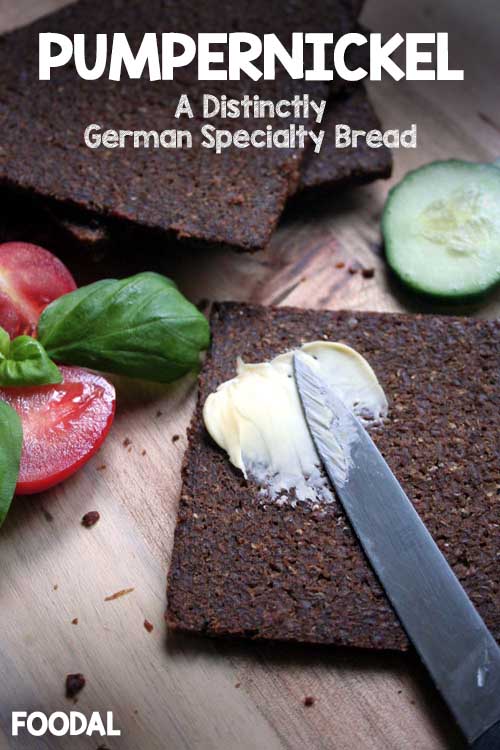
Abroad, it is often known as the “typical” German bread.
The original recipe consists of nothing more than rye flour, whole rye, and water. Just these three ingredients are needed to develop this aromatic and really special kind of bread.
Pumpernickel’s claim to fame
This type of bread is not only known for its very particular flavor, but for it’s the extremely long shelf life, too.
When shrink-wrapped (as it is usually sold), it stays fresh for a couple of months.
Believe it or not – no joking here – locked away in a tin can, it can be stored for up to two years.
Because of its long shelf life, this bread first started to obtain international popularity as so-called “army bread.”
Here’s another fun fact for you: The oldest pumpernickel bakery worldwide, which started production back in 1570, still exists in the city of Soest today (located in Westphalia, Western Germany). Led by descendants of the founders, nowadays this old-school bakery even sells their wares online.

What else is there to learn about this fascinating baked good?
The strange name, of course!
There are lots of different legends that try to explain it. Most of them are of a regional nature and they’re hard to explain, especially when they need to be translated from German into English.
Think of the word as a combination of “pumper” and “nickel,” both of which are old terms in a regional German dialect that have loads of different meanings, some of which are derogatory in nature.
[the_ad id=”18457″]
One tale claims Napoleon said the bread was good only for his horse, or “bon pour Nickel.” Others claim “pumpern” + “nickel” can be loosely translated into something along the lines of… a demon’s fart.
As to which of the stories are true? No one can say with absolute certainty.
The long road to baking pumpernickel
The baking process required to make this specialty bread is a lot more time-consuming than one might think.
First, the whole grains are soaked in water overnight to become suitable for baking. The ingredients are then mixed and baked – or rather, steamed – at a low temperature for up to twenty-four hours.
This makes it hard for common bakeries to produce it themselves, because the oven is occupied for the whole day, so it’s not available for making other baked goods.
By adding sourdough and beet syrup to the dough, the baking time could be reduced by about fourteen to sixteen hours. Making this adjustment means the total baking time required is still incredibly long, but manageable for more bakeries and even home cooks.
During the long and slow baking process, something interesting happens inside the loaf.
A special reaction involving enzymes takes place, the so-called Maillard reaction – this is the same reaction that occurs when you properly sear a chunk of meat. It converts starch into sugar and provides a sweet and intense flavor. The dark brown color is a result of it, too, making for beautiful loaves (or other baked goods, such as pretzels, if you like).
This chemical reaction is responsible for flavoring a variety of foods, like roasted coffee beans and baked or fried products.
Why you should definitely try it…
If you’ve tasted it already, then you already know: It is so different from any other bread you have tried.
To be honest, eating pumpernickel is really up to personal tastes. You’ll either love it, or you won’t.
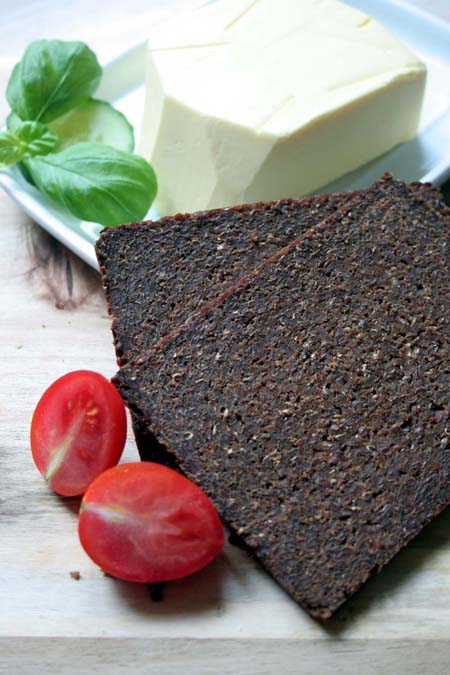
It has this unique consistency that can be described as moist and, although a bit fragile, solid at the same time, with an earthy and sweet flavor. It does not have a firm or tough crust like other types of bread, which makes it easy to bite into for people with sensitive teeth or palates, too.
If you want a more subtle taste of rye, with a crust and crumb of a traditional bread, I suggest you try my recipe for dark rye bread.
… and what you should try it with
The unique flavor and texture of this bread goes well with both sweet and savory spreads. My personal favorites, which you should definitely try, are:
- A thin layer of butter with honey and lemon curd, or orange marmalade (extremely delicious, thanks to its combination of bitter and sweet).
- Slices of roast beef, ham or smoked salmon, topped with creamy horseradish (so yummy!).
- Tomatoes, cucumbers and a slice of mild cheese (the freshness and crispness of the vegetables is a wonderful contrast to the moist, hearty bread).
- Scooped out (carefully) and filled with spinach dip or hummus.
For a simple and sweet dish to introduce you to the unique taste of pumpernickel, or to feature it in a way that you’ve never had before, try the following recipe and you’ll get to enjoy a new flavor experience.
Black Forest Pumpernickel Dessert Parfait
I really love the way Greek yogurt is used in this recipe.
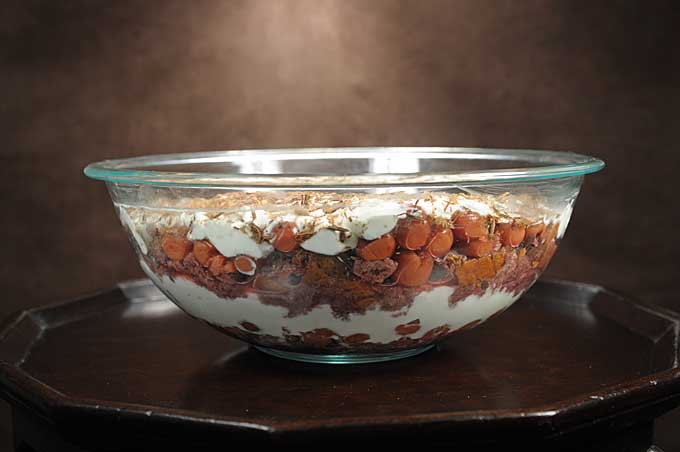
Its creamy texture and the fresh flavor really compliment the aromatic taste of the pumpernickel.

The combination of creamy yogurt, sweet cherries, shaved chocolate and the crumbled bread makes this an enjoyable must-try dessert.

If you like experimenting, why not replace the cherries with other juicy fruits, like peaches or oranges?
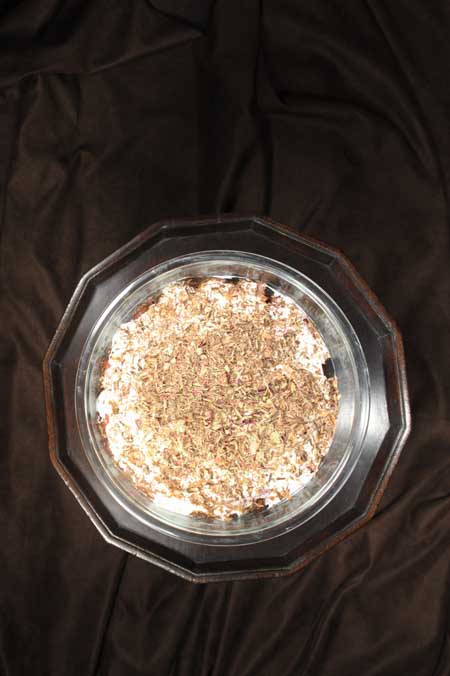
Or, you could add some chopped nuts along with the crumbled bread for a crunchy texture.
The Recipe
This easy-to make-dessert should only take you about 20 minutes or so to whip together, not including the hour long soak that the bread and brandy should receive (but you could skip the soaking step if you need a dessert in a hurry).
- 9 oz pumpernickel (about 3/4 of a loaf)
- 7 fl oz cherry brandy (about 3/4 cup + 2 tablespoons*)
- 9 oz pitted cherries (about 1 cup + 2 tablespoons)
- 2 tablespoons granulated Sugar
- 9 oz vanilla Greek yogurt (about 1 cup + 2 tablespoons)
- 3 1/2 oz grated chocolate or a scant 1/4 cup (optional)
- Crumble the pumpernickel with your hands until you have small, relatively uniform chunks. Mix with the brandy or juice in a large bowl and set aside to infuse for about an hour.
- In a small bowl, combine the cherries with the sugar.
- Layer the ingredients in a clear glass bowl or individual parfait glasses. Start with pumpernickel at the bottom, add a layer of cherries, and then put a layer of yogurt on top. Repeat until you reach the top of the glasses, or until you've used up all of the ingredients. The last layer should be yogurt.
- Sprinkle with shaved chocolate if you like, and refrigerate until ready to serve.
*You can also use cherry juice for an alcohol-free version.
[the_ad id=”18458″]
Cooking By the Numbers…
Step 1. Tear the bread into small chunks, pour on the cherry brandy or cherry juice, mix, and let it soak for an hour or so.
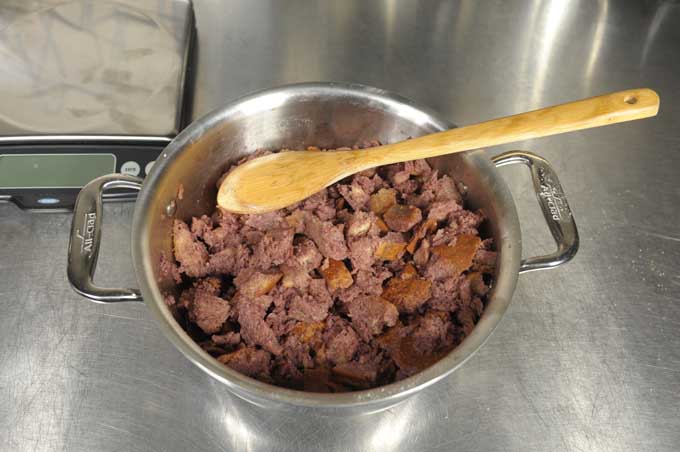
Step 2. Mix your cherries with the sugar (we’re using unbleached cane sugar here, if the color seems a little off).

Step 3. Layer your ingredients starting with the bread mixture, then cherries, then Greek yogurt, and repeat until you’ve used up everything– but be sure to end with a yogurt layer. You can use small glass jars for individual servings, a large glass mixing bowl for family style serving, or better yet, try some fancy glass serving dishes. Note the large portions in the photos – we’re making a double batch using the recipe ingredients listed below.
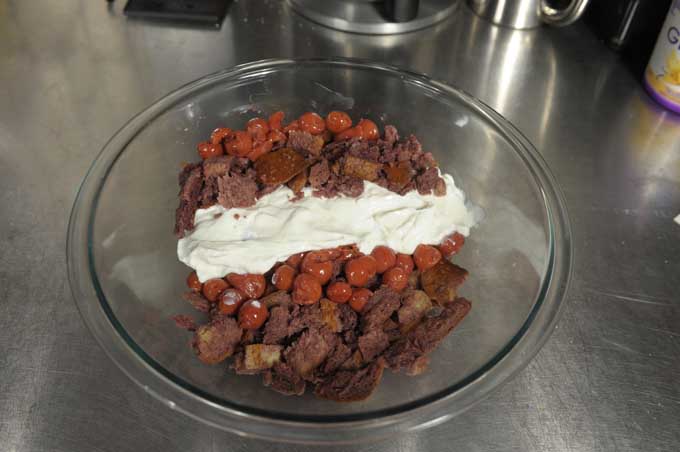
Step 4. Shave some chocolate over the top using a high quality box grater or a microplane.

Step 5. Serve and enjoy!
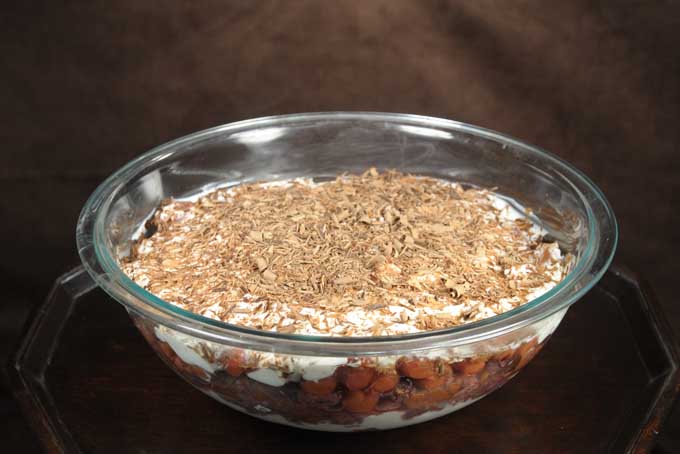
Bread photos by Nina-Kristin Isenee, Recipe photos by Mike Quinn, © Ask the Experts, LLC. ALL RIGHTS RESERVED. See our TOS for more details.
About Nina-Kristin Isensee
Nina lives in Iserlohn, Germany and holds an MA in Art History (Medieval and Renaissance Studies). She is currently working as a freelance writer in various fields. She enjoys travel, photography, cooking, and baking. Nina tries to cook from scratch every day when she has the time and enjoys trying out new spices and ingredients, as well as surprising her family with new cake creations.





This bread must be the king. It’s the first time I hear about it and its history is at least curious and interesting. First its color is extremely unusual. Everyone knows that the seed bread is darker, but I’ve never seen such a dark bread like this. The curiosities and facts you mentioned about it just piqued my curiosity. A bread with a durability out of the ordinary and that probably fed many mouths during the war? This is more than a bread, it’s an archaeological find. Good to know that the place where it all began remains intact and in the hands of descendants. This means that people continue to value the handmade way of doing things. It must have a very interesting and peculiar flavor. Unfortunately I don’t know if I can acquire this bread here in japan. Anyway, I don’t think it’d have the same mysticism. Germany is an interesting country.
Thank you for your comment! I agree with you in all points, it has such an interesting history and this unbelievably long durability. You are right about the production that is still in the family. I think this is a precious fact and shows how tradition can be held up over decades!
It might really become difficult to get this in Japan, I suppose. What a pity! But great to hear that you enjoyed the article anyway, thanks.
I never knew the origin. I just knew I liked it. I had it often as a child.
Nice! I’m happy that I could make you remember knowing and liking it!
Oh my God, the demon’s fart story made me look different at my favorite bread!
I had no idea that it’s German. I never thought about were it’s from, even though I’ve enjoyed it for years.
Pumpernickel is very special for sure.
I really like the desert idea too! Looks tasty.
Thank you. Sometimes it can be really surprising if one finds out about the origin of certain products, right? There are lots of things that have an interesting history, in this case, it’s funny, too 😉
The recipe is a popular dessert in a few regions here, especially in parts of Westphalia where the bread originally comes from. I think they’d agree if I call it their national dessert!
Wow, I’ve never heard of that dessert, but it sounds delish. Frankly, I’d be quite happy with some of the bread itself, just toasted with real butter and some orange marmalade. That sounds heavenly to me. I like rye toast the same way, but there is something special about the dark deliciousness of this type instead. Yum.
I’m the only one around here who likes it, but I have to treat myself to some occasionally. I usually end up freezing some.
Oh yes! The marmalade and butter combination is fantastic. I just love it for breakfast or as a last sweet snack after dinner. Freezing it works fine, too. And don’t worry about being the only one who likes it: no need to share and there remains more for you to enjoy 😉
After reading about how much effort it takes to make it, I have a new appreciation for this bread. I’ve been a fan of it for years and used to use an apple butter on it that was a hit with my family. I appreciate the touch of history as well, that will be some fun trivia to share with my German family. I’ll continue to enjoy this bread, but I doubt I’ll be making it!
Oh, apple butter sounds yummy! I imagine this must be a delicious combination, really. There seem to be many users with German heritage and family, that is so interesting. 🙂 Maybe your family members know some of these facts?!
Preparing it on one’s own takes a lot of effort. I haven’t done it myself, because in this case, I just need to go to a bakery nearby and get some slices. They make it the “pure” way, without additives or else, so this is a lot easier 😉
My mom always got our bread from a German bakery that was around the area that she worked in. I was told that my great grand mother would make it, but after she got older, it started to not turn out so great. After reading the article and knowing how much goes into making it, I can see where it could be a chore for someone in their 80’s. I actually read this thinking that I might try it, but between kids and life, I’ll have to stick with the bakery myself!
Great, well, I suppose your mom brought home some wonderful loaves back then. You’re right, it might be a bit too much work in that age. And, like you say, sometimes it’s just life that comes in between and leaves you no patience for a bread like this. Either way, enjoy the bakery-version then 🙂
The color of that bread is truly incredible, and I love all the little facts that you included in this post. Seriously, I never knew that it could be stored away up to two years in a tin can.
That is quite amazing, isn’t it? I think nowadays no one would actually need bread that lasts this long, but I believe that this was really useful in earlier times. Thanks, I appreciate that you liked the post!
Oh my, these ideas and the recipe look fabulous! I like pumpernickel but I have a feeling that I’ve never really had the authentic taste of it… my local bakeries do great with some kinds of breads, but I think in order to taste it like it’s supposed to be, I’d have to visit Germany. Considering it’s my ancestor’s homeland, it could very well happen someday! 🙂
I need to try it with orange marmalade as you suggested… that sounds so good!
Great, you definitely have to do that! If anyone is planning to visit me, go ahead, and we can prepare some of the nice recipes I posted here, that’d be fun 😉
But I think you might be right about the flavor, maybe the texture, too. I think when products and their preparation process are being “exported” to another country, they will still somehow end up a little bit different. So, if you like the one you are able to get at your local bakeries, keep enjoying it!
I have heard of pumpernickel but not the stories behind it. Some of these rumors are probably pretty silly even in english. I would like to try it out for myself. It is pretty cool that it can last for a couple of years if stored right. As usual I am always learning something new to share with others.
That’s right, some of the explanations are more trustworthy than others.. And thanks, we’re happy to keep you interested and excited here on Foodal!
I had heard the name Pumpernickel before, but had no idea what it meant or that it was even food related. The process of making the Pumpernickel bread does seem long, but I would like to try making it at least once. I would love to taste it. It just looks so trendy and cool looking! The Black Forest Pumpernickel Dessert Parfait looks to die for too! When I finally give making Pumpernickel a try, I will definitely take the opportunity to make the Black Forest Parfait. Thanks for the recipe, and thanks for the sharing this interesting bread’s history!
Indeed, it takes so long to prepare and bake it. Maybe I will make a loaf on my own one day in the future. When I should do that, I will let you know! And then it’d be time to prepare this special dessert. Maybe you’ll find another dark and rustic bread you could try it with until then.
Thanks goes to you readers, I’m happy that you enjoy all the stories and recipes! 🙂
This is yet another of my first heard in Foodal moment! I really don’t think I’ve seen pumpernickel (wow! that’s a mouthful to say) being sold in any of our bakeries here, or even in specialty restaurants [not that there are german restaurants where I’m from]. Nevertheless, when I was looking at the picture, I initially thought the bread had some chocolate in it. Didn’t expect that enzyme chemical reaction thingy explanation.
Anyway, I could never imagine having the patience to whip up something that takes so long to make. May I ask, that given the time preparation, is this bread expensive? As in, is it considered gourmet goodies? OR it’s fairly common in Germany?
Yummy, chocolate pumpernickel, I would support that! But when I look at the photos, I can totally understand why one could think that! Actually, it is indeed really interesting that – despite the baking process – the bread is quite inexpensive and there are a lot products that cost much more.
In earlier times, it was more of a rustic and traditional food, not quite popular. But today, people are appreciating eating habits and local traditions again, so it had some kind of revival 😉 However, sometimes it is hard to get it in bakeries, because many of them do not offer it – or only on special days of the week (I suppose when they can allow the oven to be blocked). But one is definitely able to get it pre-packed in large grocery stores.
I LOVE pumpernickel! Like some of the other commenters, I don’t know if I have experienced the true taste of an authentic loaf. I have bought good quality bread, but I can’t be sure if it has been made in the true fashion. Thank you for sharing the dessert recipe. I have never thought to use it in that food category! I’ve always used it for sandwiches. I’m interested to try the recipe you shared!
You’re welcome, it’s always interesting to play with different flavors. As the original bread (the loaves you get probably, too) have this sweet nuance, they work nice in a dessert, although it doesn’t seem to fit at a first glance. 🙂 Good luck and enjoy this unusual combination!
Pumpernickel has always been one of my favorite breads, and I’m disappointed that it doesn’t really get the attention it deserves. These are also some pretty interesting facts here … I had no idea that the shelf life was that long. And that parfait looks great! I’ll definitely have to give that a try 🙂
As a fan of rye bread this is something I definitely want to try when I travel to Germany. I’ve not had the luxury of trying it yet as it’s not available where I live.
It certainly seems like it’ll be a unique and impressive bread, as representative to Germany as the baguette is to France.
What a curious history this bread has! In reading through its origins and its quality life span it made me think about Lembas bread from the Lord of the Rings! am I the only one? I can only imagine that this real life bread must have saved a number of lives during the devastating war. I believe this to truly be a national treasure for Germany it deserves to be celebrated. I myself have never tried this bread before but now I can’t wait to. I certainly will make a stop by the bakery before the end of the week. And when I do take my first bite of Pumpernickel bread I will have a great appreciation for it. Thanks for sharing!
Haha, that is one great thought that hasn’t crossed my mind until now 😉 When I think about it, there are indeed some similarities, you’re right: Long durability, filling and a simple, yet exceptional look. Would be interesting to find out if there is any type of bread Lembas should be based on.. We could start researching here, I suppose!
I hope you are going to find a loaf at your bakery and enjoy a slice of this wonderful bread.
Oh, WOW thank you for this! I haven’t had good pumpernickel in so many years. My Softa used to make it for me when I was a kid. Actually, I don’t think that I’ve had it since she died. I used to eat it with hot red pepper jelly when I wanted to feel like an “adult” at tea time.
Even then I had no idea of the history of the bread at all.
I’m making this desert this weekend, it looks perfect. It’s not too sweet looking and would be the perfect tartness on a cold day with some mulled red wine. Thanks again!
Oh wow, hot red pepper jelly sounds really intriguing to me. I love hot food and I can imagine this combination works out so well. I’m happy that this has inspired you to try the recipe. Especially with some mulled wine in a cozy atmosphere, it should taste wonderful. Enjoy!
Wow, this was a great article! Pumpernickel has always been one of my favorite breads, but I never knew any of this stuff. Very interesting. This article also reminded me that it’s been far too long since the last time I had pumpernickel. Thanks!
Thank you, I’m glad you enjoyed the article. I am also happy to hear that so many people have heard of pumpernickel before and seem to really like it.
So, if you didn’t have it in a while, I hope you’ll find a place where to get some 🙂 I wish you success!
To be honest, before this article, I hadn’t put much thought into what traditional German bread was like. The closest I’ve come to eating pumpernickel is the rye on a Reuben sandwich (my favorite), still I think I would most likely enjoy it. I was completely unaware of the bread’s history and staying power as well, it sounds like it is worth trying for sure. The next time I’m at the store or deli I’ll have to check it out.
I needed to look up the Reuben sandwich and now I’m pretty sure that it must taste amazing! And I can imagine that pumpernickel would indeed go well in that combination (although it is a bit more crumbly than usual rye bread), but the flavor would be great. I’ll keep my fingers crossed that you find a version of it, good luck!
“Demon’s Fart” ahahahaha! Never would’ve expected that!
I’ve never heard of pumpernickel before… Although I think I’ve already seen it… But probably wasn’t termed as “pumpernickel” on the box. Haha. It tasted… weird… Everyone except me and my brother liked it though… But since I was a kid then, maybe I just couldn’t appreciate its flavor. And I’d like to try it now, again 🙂
The stories one has never heard of, are often the best, right? 😉 I’d be happy if you tried it again today, maybe – knowing about its interesting background – you’ll enjoy it!
Wow thank-you so much for all that excellent information. It’s strange but I never liked pumpernickle bread, it always tasted too strong for me, somewhat drowning out anything you put on it, bitter and not something I wanted much to eat. This has changed though and I now love it.
Could be something you grow into, like children do olives, veggies and marmelade.
Now I live many thousands of miles from Europe I suddenly had the chance to try it again after a dear German friend brought me some as a special gift all the way from Köln. I was utterly blown away how much I liked the taste. I have been trying all sorts on it too finding one blissful combination after the next. Basicaly it goes with just about everything and I love the texture and richness of it. One of the “loaves” he brought me was a cocktail pumpernickle. A treasured heavy foil wrapped tube of small moist round coins of heaven that fit just a bite of your favorite things.
I wondered why this bread lasts so long, the salt content is quite high but not that you can taste it. Other than salt it has nothing else by way of artificail additives. Does the baking process conserve it somehow? Once opened I keep it wrapped in the fridge. However my friend assures me the unopened ones I can just leave in the cupboard for a few months. Utterly remarkable brot that it is!
Thought I would add that German bread rolls are the best on the planet, Austrian ones perhapse come a close second. We used to go down to the bakery every weekend and get a whole assortiment of wonderfully varied brötchen and semmeln for breakfast when I lived near Düsseldorf. Utterly scrumptious and toothy. Along with schinken, delectable German cheeses and soft boiled eggs the best breakfast you can ever wish for. I can still taste it now. The German breakfast should be world famous. What do I know maybe it is! Healthier by far than a full English too. LOL
I was trying some different foods with pumpernickle because I ran out of spinach dip and i’ve realized if you warm it up in a toaster/oven/microwave, then butter it and sprinkle grated cheese on it, it tastes so good.
Thanks for the delicious serving suggestion! I’ve always been a fan of peanut butter and jelly on pumpernickel.
Nina,
your reviews and recipes are surely a boon for the pumpernickel lover, but I have a different issue. I ate pumpernickel when I lived in Heidelberg and it was fantastic. My problem is that I cannot find that type anywhere. It was very thin and very dark and not like any I have found yet anywhere online, one from Mestemacher, and the other from Landesberg. If you know of what I speak and have any input about sourcing such a bread I would love to hear from you.
When you say it was vey thin, do you mean it was sliced thin? Westphalian pumpernickel is usually very dark and dense, and it is made without yeast. This may be what you’re looking for.